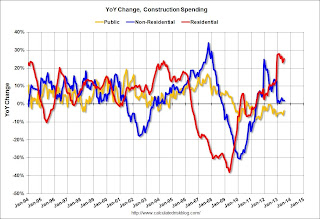The Census Bureau reported that overall construction spending increased in July:
The U.S. Census Bureau of the Department of Commerce announced today that construction spending during July 2013 was estimated at a seasonally adjusted annual rate of $900.8 billion, 0.6 percent above the revised June estimate of $895.7 billion. The July figure is 5.2 percent above the July 2012 estimate of $856.3 billion.
…
Spending on private construction was at a seasonally adjusted annual rate of $631.4 billion, 0.9 percent above the revised June estimate of $625.6 billion. …In July, the estimated seasonally adjusted annual rate of public construction spending was $269.4 billion, 0.3 percent below the revised June estimate of $270.1 billion.
 Click on graph for larger image.
Click on graph for larger image.
This graph shows private residential and nonresidential construction spending, and public spending, since 1993. Note: nominal dollars, not inflation adjusted.
Private residential spending is 51% below the peak in early 2006, and up 46% from the post-bubble low.
Non-residential spending is 28% below the peak in January 2008, and up about 32% from the recent low.
Public construction spending is now 17% below the peak in March 2009.
 The second graph shows the year-over-year change in construction spending.
The second graph shows the year-over-year change in construction spending.
On a year-over-year basis, private residential construction spending is now up 25%. Non-residential spending is up slightly year-over-year. Public spending is down 4% year-over-year.
To repeat a few key themes:
1) Private residential construction is usually the largest category for construction spending, and is now the largest category once again. Usually private residential construction leads the economy, so this is a good sign going forward.
2) Private non-residential construction spending usually lags the economy. There was some increase this time for a couple of years – mostly related to energy and power – but the key sectors of office, retail and hotels are still at very low levels. I expect private non-residential to start to increase later this year.
3) Public construction spending decreased in July. Public spending has declined to 2006 levels (not adjusted for inflation) and has been a drag on the economy for 4 years. In real terms, public construction spending has declined to 2001 levels.